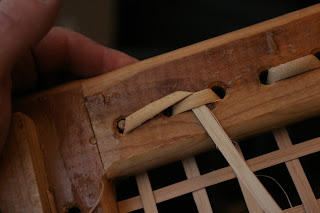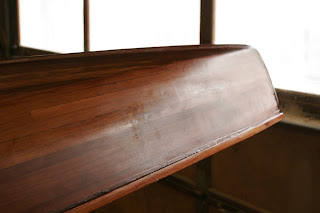The seat is installed in the 11 footer. It now has a name.
The Kaskaskia, after the river of the same name. Future versions of the Kaskaskia will probably get a little longer.
Here is the Wiki entry:
The Kaskaskia River is a tributary of the Mississippi River, approximately 320 miles (515 km) long, in central and southern Illinois in the United States. The second largest river system within Illinois, it drains a rural area of farms, as well as rolling hills along river bottoms of hardwood forests in its lower reaches.
Saturday, January 29, 2011
Paddle Faster !!!
The St. Louis boat show is in two weeks so we are in full press mode on paddles.
Here is one getting a glass/epoxy skin.
Here is one getting a glass/epoxy skin.
Monday, January 24, 2011
Wicker work
The seat for the current kayak is a simple grid pattern wicker. These photos show how the rattan fibers are terminated on the underside of the seat.
After the fiber is wrapped a couple of times it can't back out.
Natural and comfortable!
Almost done.
After the fiber is wrapped a couple of times it can't back out.
Natural and comfortable!
Almost done.
Friday, January 21, 2011
Seat frame work
A seat frame for the 11 footer begins with ripping 4 quarter cherry to 1&1/4 inches.
It is then set with hardwood dowels and glued.
Next it gets routered and a wicker plan.
The holes are drilled and chased with a counter sink bit.
It is then set with hardwood dowels and glued.
Next it gets routered and a wicker plan.
The holes are drilled and chased with a counter sink bit.
Tuesday, January 18, 2011
Bow stem
Sunday, January 16, 2011
11 foot Kayak
Wednesday, January 12, 2011
finished paddles #cp2 & sup#1
Here are some photos of a canoe and a stand up paddle board paddle.
The finish on the sup is epiphanies varnish and the canoe paddle is teak oil.
The finish on the sup is epiphanies varnish and the canoe paddle is teak oil.
Tuesday, January 11, 2011
Additional paddles
Monday and tuesday we worked on the canoe paddle fabrication techniques.
After taking stock of our current wood supply, we started cutting shaft blanks out of cherry sap wood and picking out pretty sections of heart wood for the blades.
Walnut and fir sections are being cut up as well.
This is a paddle made of WRC shaft with MO. hogany handle.
Maple dowels are visible prior to epoxy.
Below is the handle after rough sanding.
After taking stock of our current wood supply, we started cutting shaft blanks out of cherry sap wood and picking out pretty sections of heart wood for the blades.
Walnut and fir sections are being cut up as well.
This is a paddle made of WRC shaft with MO. hogany handle.
Maple dowels are visible prior to epoxy.
Below is the handle after rough sanding.
Wednesday, January 5, 2011
new paddle design
Today we finished whittling our first paddle design. It is cherry plank construction with a redwood detail. (redwood was salvaged from an old deck) It has an oiled finish now but will get a varnish topcoat in a couple days. It is 66 inches long...
Tuesday, January 4, 2011
Hull #1
A new canoe in the world.
Niangua 16 canoe is a durable tripping canoe with a nice tumble home profile for a classic look.
It is 16 feet long with a beam of 32.5 inches and a stem height of 20 inches. It weighs 75 pounds? No scale yet.
The Niangua river is fed by Bennet
Springs. It is reported variously as the third or fourth largest in the state of Missouri, with an average daily flow of about one hundred million gallons and is the centerpiece of Bennett Spring State Park.
Missouri's Niangua River
One of the best fishing streams in the state, the Niangua also has the advantage of being closely associated with Bennett Spring State Park and one of the Conservation Department's trout hatcheries. Those who prefer floating to trout fishing in the park often make the park their headquarters while floating the upper sections of the river or the section immediately below the park. However, the river itself provides many fine campsites for put-in-and-go type floats. In high water, a float could be made from as high as Hwy. M, but the river above Hwy. 32 is seldom floatable.
River description Courtesy of Mo Dept of Conservation.
Subscribe to:
Posts (Atom)





























